 |

For further information, contact the MBL Communications Office at (508) 289-7423 or e-mail us at comm@mbl.edu
For Immediate Release: July 28, 2011
Contact: Diana Kenney, MBL, 508-289-7139; dkenney@mbl.edu
Scientists Report Dramatic Carbon Loss From Massive Arctic Wildfire
Impacts could have profound implications on atmospheric carbon and climate
 |
 |
 |
Resources
Feature Article: An Arctic with Fire
The Gaius Shaver Lab
Photos:
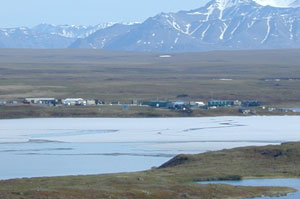
Toolik Field Station in the northern foothills of the Brooks Range, site of the NSF’s Arctic Long-Term Ecological Research (LTER) project. Credit: Courtesy of Jim Laundre, MBL Full size image
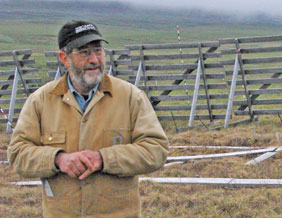
Gaius (Gus) Shaver, an ecologist from of the MBL Ecosystems Center, directs the NSF Arctic LTER. Credit: Jason Orfanon/MBL Logan Science Journalism Program Full size image
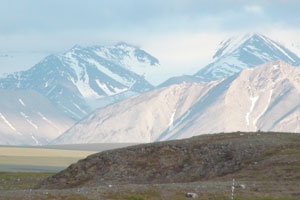
The Brooks Mountain range, which curves along the southern border of the North Slope region of Alaska. Credit: MBL Logan Science Journalism Program Full size image
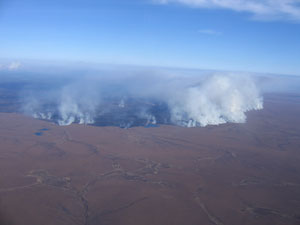
Sparked by lightning in mid-July of 2007, the Anaktuvuk River Fire burned more than 400 square miles before snow put it out in early October. Credit: Bureau of Land Management, Alaska Fire Service Full size image
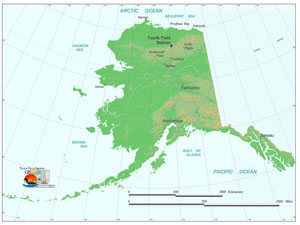
Alaska map courtesy of Toolik Field Station GIS Service. Full size image
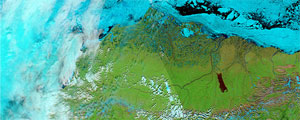
The Anaktuvuk River Fire is the dark shape in the right-center of this NASA-MODIS image of the North Slope of Alaska, acquired June 14, 2008. The burned area is bordered by the Nanushuk River on the west and the Itkillik River on the east. Credit: Courtesy of Jim Laundre, MBL Full size image

Charred earth at the site of the Anaktuvuk River Fire, June 2008. Credit: Jason Stuckey, Toolik Field Station Full size image

MBL Ecosystems Center scientist Chris Neill inspects burned tussocks at the Anaktuvuk River fire site, July 2008. Credit: Jason Orfanon, MBL Logan Science Journalism Program Full size image
|
WOODS HOLE, MA—In a study published in this week’s issue of Nature, Marine Biological Laboratory (MBL) senior scientist Gauis Shaver and his colleagues, including lead author Michelle Mack of the University of Florida, describe the dramatic impacts of a massive Arctic wildfire on carbon releases to the atmosphere. The 2007 blaze on the North Slope of the Alaska’s Brooks Mountain Range released 20 times more carbon to the atmosphere than what is annually lost from undisturbed tundra.
As wildfires increase in frequency and size along Alaska’s North Slope, the team contends the disturbances may release large amounts of the greenhouse gas CO2 to the atmosphere and accelerate the transformation of the frozen, treeless tundra of today into a different kind of ecosystem less capable of storing carbon. Together, the impacts could have profound implications on atmospheric carbon and climate.
Arctic tundra landscapes store huge amounts of carbon in cool, wet soils that are insulated by a layer of permanently frozen ground, or permafrost. Fire has been almost nonexistent in Alaska’s North Slope for thousands of years and the effect of fires on the carbon balance of tundra ecosystems is largely unknown. However, with warming temperatures over the past half-century, the climate in the region is in transition, spurring more thunderstorms, lightning, and wildfires.
In 2007 the Anaktuvuk River fire ravaged a 40-by-10 mile swath of tundra about 24 miles north of Toolik Field Station, where Shaver is the principal investigator of the NSF’s Arctic Long-Term Ecological Research project. The blaze was the largest ever recorded in the region.
While the Anaktuvuk River fire scorched only upper soil layers that are about 50 years old, it caused the release of more than two million metric tons of CO2 to the atmosphere. This amount is similar in magnitude to the annual carbon sink for the entire Arctic tundra biome averaged over the last quarter of the twentieth century. According to Shaver and his colleagues, an Arctic regularly disturbed by fire could mean massive releases of CO2 into the atmosphere, a decrease in carbon stocks on land, and a rapid impact on climate.
Shaver has been studying the Arctic tundra since the mid-1970s, and he knows how to look for gradual shifts in a landscape that is changing, but very slowly. Large disturbances such as fire—which leave the land open to rapid re-growth—have been rare. As the tundra rebounds from the Anaktuvuk River fire, Shaver and his colleagues are watching closely to see if the fire will nudge a major transformation of the North Slope groundcover that is already slowly underway.
More shrubs are expected to appear in the Arctic landscape as the climate warms, a trend that may be accelerated by the advent of fires. “Satellites tell us there has clearly been a greening of the Arctic over the past 30 years,” Shaver says. Many observations point to a warmer landscape that will be dominated by shrubs, rather than the grasses and mosses of today. Some scientists forecast that large parts of the Arctic tundra will eventually become forest. “A key question is whether the conditions on these burn sites are more favorable for the establishment of new seeds, new species,” Shaver says.
Moreover, the burn, because it is darker, absorbs more solar radiation than undisturbed land. “You have much higher rates of permafrost thawing, and depth of thaw, on the burn,” Shaver says. All of these immediate consequences of the Anaktuvuk River fire reinforce the effects of a warming climate on the Arctic tundra. And the scientists don’t yet know if the land can recover the carbon and energy balance of its pre-burn state, or if they are looking at a “new normal,” Shaver says.
This research was supported by the NSF Division of Environmental Biology, the Division of Biological Infrastructure, and Office of Polar Programs, the National Center for Ecological Analysis and Synthesis, and the Bureau of Land Management Alaska Fire Service and Arctic Field Office.
The Marine Biological Laboratory (MBL) is dedicated to scientific discovery and improving the human condition through research and education in biology, biomedicine, and environmental science. Founded in 1888 in Woods Hole, Massachusetts, the MBL is an independent, nonprofit corporation.
|